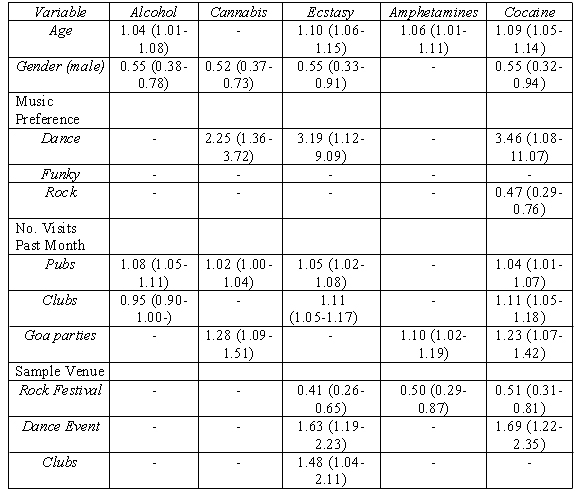Celebrity DJ, Deadmau5 recently called out Madonna through Twitter for alluding to ecstasy during a music festival. The DJ contended that Madonna irresponsibly promoted ecstasy use by asking the crowd how many of them had “seen Molly” – a slang term for ecstasy. This incident made headlines around the world and strengthened the perceived association between club music and ecstasy. This week, Addiction & the Humanities reviews a study that examined the potential connection between music preferences and drug use behavior among visitors to European dance, club, and rock musical events (Van Havere, Vanderplasschen, Lammertyn, Broekaert, & Bellis, 2011).
Methods
- The researchers recruited 1406 individuals (i.e., inviting every 5th visitor) who were attending nighttime music events in Belgium during 2007 at three clubs, two dance events, and two rock events.
- 775 (55.1%) of the recruited attendees completed a 5-10 minute survey consisting of questions about demographics, nightlife habits, music preferences, and drug use. 62% of respondents were male and the mean age was 22.7 (SD=5.9).
Results
- Music preference was associated with a number of sample characteristics, such as age. For instance, respondents recruited at clubs were significantly younger than those recruited from dance and rock events (F(2, 717)=12.20, p<0.01).
- About 92% of respondents reported past-year alcohol use and almost 52% reported past-year illegal drug use (from most likely to least likely: cannabis, ecstasy, cocaine, amphetamines).
- Separate regression analyses for each drug suggested that music preferences were associated with frequency of drug use behaviors (no, occasional, regular use; see Table 1 for details). However, other factors, including age, gender, nightlife habits, and venue also were associated with specific types of drug use.
Table 1. Odds ratios and 95% CIs for final regression models predicting different types of drug use (Adapted from Van Havere et al., 2011)

Note. Odds ratios are significant if the CI does not include 0; odds ratios that did not reach significance are not included.
Limitations
- The representativeness of the study participants and the recruitment events is uncertain, limiting the generalizability of the findings.
- The study design does not allow for the determination of causation; we cannot conclude that music preference influenced drug use.
- Music preference samples differed by a number of other sample characteristics (e.g., age), so it is difficult to determine whether those characteristics or the music preferences were responsible for the observed associations.
Discussion
There is an ongoing public perception that certain types of music are more strongly associated with specific drug use. Van Havere and her colleagues suggest that some music preferences might be markers for certain types of drug use. Importantly, this study does not establish that listening to certain types of music cause people to begin using drugs; however, music preference might be a useful marker of risk for drug use. The identification of such markers is important to drug use prevention efforts, and therefore, more research in this area is warranted.
– Debi LaPlante
What do you think? Please use the comment link below to provide feedback.
References
Van Havere, T, Vanderplasschen, W., Lammertyn, J., Broekaert, E., & Bellis, M., (2011). Drug use and nightlife: More than just dance music. Substance Abuse Treatment, Prevention, and Policy, 6(18), open access.




